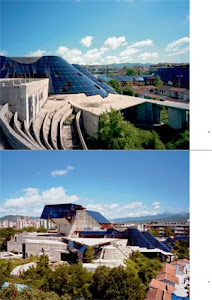SOCIALIST FORM
Socialist Architecture
Tobia Bezzola, Srdjan Jovanovic Weiss (a cura di),
JRP|Ringier, Zurigo 2012.

Il progetto di collaborazione, avviato nel 2009, tra il fotografo Armin Linke e l’architetto Srdjan Jovanovic Weiss ha documentato lo stato di fatto di alcune architetture realizzate nell’ex Jugoslavia socialista e il destino di abbandono o trasformazione che hanno conosciuto nelle democrazie emerse dalle trasformazioni politiche degli anni novanta.
Lo spunto iniziale nacque a Skopje, dove Linke venne invitato a un convegno sull’architettura socialista. Da allora – era il 2009 – l’indagine è proseguita in Bosnia, Serbia, Montenegro e Croazia; gli ultimi scatti risalgono all’anno scorso.
Dopo le trasformazioni avvenute nell' ex jugoslavia molte di queste architetture sono rimaste vuote, in termini d'uso e di significato, da simboli del regime si sono trasformati in rovine moderne. Attraverso questo lavoro di documentazione si catturano in un certo senso le indecisioni rispetto a come comportarsi di fronte a questi edifici di cinque democrazie emergenti: Croazia, Bosnia-Herzegovina, Montenegro, Macedonia, e Serbia.
Il confronto con il proprio passato è sempre difficile, e questi edifici lo rappresentano, ma non riuscire a reagire incorporandoli nel proprio futuro é forse l'errore più grande.






The beauty of Soviet brutalism
Photographer Frédéric Chaubin
Taschen 2011

Photographer Frédéric Chaubin reveals 90 buildings sited in fourteen former Soviet Republics which express what he considers to be the fourth age of Soviet architecture. His poetic pictures reveal an unexpected rebirth of imagination, an unknown burgeoning that took place from 1970 until 1990. Contrary to the 1920s and 1950s, no “school” or main trend emerges here. These buildings represent a chaotic impulse brought about by a decaying system. Their diversity announced the end of the Soviet Union. Taking advantage of the collapsing monolithic structure, the holes in the widening net, architects went far beyond modernism, going back to the roots or freely innovating. Some of the daring ones completed projects that the Constructivists would have dreamt of (Druzhba Sanatorium, Yalta), others expressed their imagination in an expressionist way (Palace of Weddings, Tbilisi). A summer camp, inspired by sketches of a prototype lunar base, lays claim to Suprematist influence (Prometheus youth camp, Bogatyr). Then comes the "speaking architecture" widespread in the last years of the USSR: a crematorium adorned with concrete flames (Crematorium, Kiev), a technological institute with a flying saucer crashed on the roof (Institute of Scientific Research, Kiev), a political center watching you like Big Brother (House of Soviets, Kaliningrad). This puzzle of styles testifies to all the ideological dreams of the period, from the obsession with the cosmos to the rebirth of identity. It also outlines the geography of the USSR, showing how local influences made their exotic twists before the country was brought to its end.
Frédéric Chaubin's Cosmic Communist Constructions Photographed is elected best book on architecture of the year by the International Artbook and Film Festival in Perpignan/France (Festival International du Livre d'Art & du Film Perpignan). The photographer: Frédéric Chaubin has been, for the last fifteen years, editor-in-chief of the French lifestyle magazine Citizen K. Since 2000 he has regularly featured works combining text and photography. The CCCP collection research was carried out from 2003 to 2010, through an intuitive and creative travel process. This project has been shown throughout the world, from Japan to the United States.





